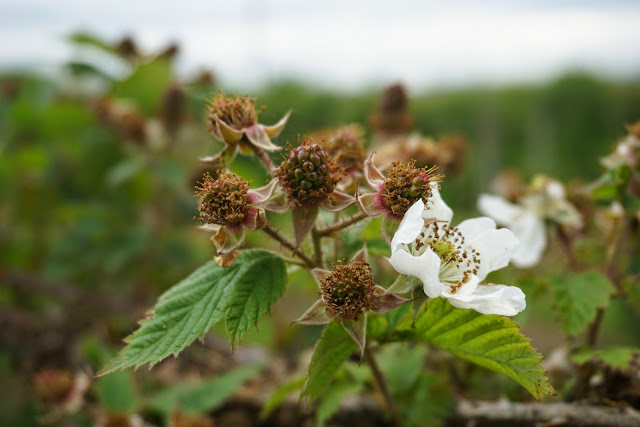 |
| The middle of the field is too hard to rototill. Florencio is setting out sprinklers to soften it up. |
 |
| This sprinkler keeps tipping itself over with the high water pressure needed to shoot the water far. |
 |
| This sprinkler is getting the boot. He has turned it off and headed out to get a different one. |
 |
| Purposeful strides toward a different sprinkler. |
 |
| The compost pile grows some interesting things this year. Hmmm. |
 |
| New growth on the tea plants will be harvested for the boxes on Tuesdays. |
 |
| Bosc pears are getting larger. |
 |
| These persimmon buds are so different. |
 |
| Grapes are adding length in their stems and in their clusters. |
 |
| Florencio found three sprinklers to stand up and throw water a good distance. He will let them run for a few hours and then move to the dry areas, and then repeat. |
 |
| Foreground, large leafed spinach. Background, varieties of lettuce and to the right, peas climbing upward. |
 |
| The drip needs mending. Actually it needed plumber's tape. It did blow a bit of dirt around when it came apart. The middle line took the dirt down to the asparagus roots. |
 |
| Beets have really nice beet greens this year. So far. Knock on wood. Or you could read this as, critters haven't found them yet. |
 |
| Many baby peas amidst the white blossoms. |
 |
| The Utah celery has many new stems growing strong. |
 |
| We are enjoying watching the red celery mature. |
 |
| I thought this Swiss chard had "wine" in its name. It is actually "Red Magic". |
 |
| Rhubarb Swiss chard. |
 |
| Golden chard near some Red Magic. |
 |
| Original "Fordhook Giant" Swiss Chard. |
 |
| "Red Ursa" kale. |
 |
| Some of the Red Ursa is curlier than others. |
 |
| Double rows of onions with their drip at the far end of the field. |
 |
| Blackberries are getting larger. The center berry in the cluster usually matures first and ripens first and therefore gets eaten first. Generally they are bigger, too. |
 |
| This cluster of raspberries are a tad behind the blackberries in maturity. |
 |
| These raspberry flowers have opened. |
 |
| This branch of raspberries has light green fruit hanging down. |
 |
| The draped black netting protects the strawberries underneath from the birds who love them. |
 |
| Raspberries have many thorns to protect them. |
 |
| Excited to see broccoli heads forming. |
 |
| This is a "Purple Sicily" cauliflower plant. |
 |
| Greenhouse tomatoes are tall with many yellow blossoms. |
 |
| Another planting of cauliflower has started to grow. |
 |
| We are trying out this variety of butternut squash this year. The mice ate off the top leaves of most of these. Florencio has since replanted this flat and the new seeds are up. |
 |
| Cute lemon cucumbers in the greenhouse. |
 |
| Since I love all tomatoes, it seems like these first ones stay green FOREVER. I am excited for the first ripe ones. |
 |
| The cucumbers that don't run into something when they grow tend to be straighter than the ones that hit the side of the pot and curl. |
 |
| Baby slicing cucumbers with their sunny yellow flower still attached. |
 |
| One of Mom's bleeding hearts peeking through the fence. |
 |
| Sweet cicely is an edible herb that is duh, sweet. All parts of the plant are edible. |
 |
| Sweet cicely has fernlike foliage and white flowers that mature to the somewhat crunchy seed pods that some use as sweetener. |
 |
| Verbascum has large low growing leaves and sends up pretty spires. |
 |
| The variegated foliage of these irises could be yellow and green or white and green. Both are beautiful in the garden. |
 |
| White foxglove. |
 |
| A David Austin rose flower surrounded by its "buds". |
 |
| Many more to open. And they smell so sweet. |
 |
| A speckled long stem rose. |
 |
| Aphids love roses. They love some plants more than others. |
 |
| This must be extra tender new growth. |
 |
| Aphids could be green, brown, black. They could be wingless, or have wings. They are born pregnant so reproduce like crazy. |
 |
| A David Austin rose nestled between its buds. |
 |
| This delicate pale yellow rose does not stand up to being put in bouquets. We enjoy it on its bush. |
 |
| This delicate white rose also falls apart almost as soon as it is picked. |
 |
| This orange rose is hardy enough for the bouquets. It has nasty thorns. |
 |
| A triple center. |
 |
| A David Austin cluster. |
 |
| Old school roses tend to have different foliage as well. Sometimes it smells like green apples. |
 |
| The small persimmon tree near the greenhouses has many buds. |
 |
| It's hard to wait for these to bloom. So beautiful. See you next time on the "Planting Day" post! |






